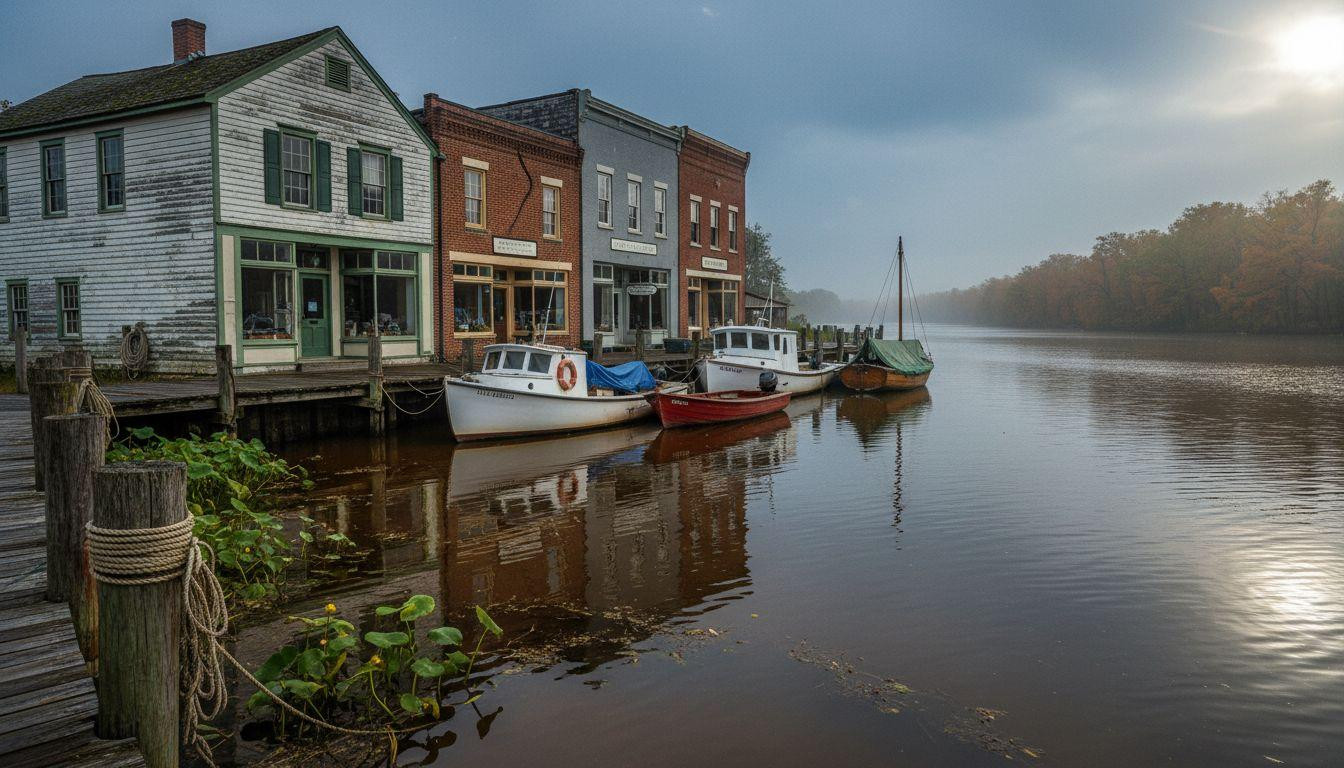Morning mist rises from the Pocomoke River in Snow Hill, Maryland, where Victorian storefronts catch golden November light. While 3 million tourists crowd Annapolis’s commercialized waterfront, Maryland’s Eastern Shore guards a 60-mile corridor of authentic colonial ports. Here, watermen still harvest crabs at dawn, 17th-century architecture stands preserved, and accommodations cost half the price. This forgotten maritime corridor offers what Annapolis lost decades ago: genuine working waterfronts, local seafood festivals, and colonial history you can touch without crowds.
7 colonial waterfront towns along Maryland’s Eastern Shore that rival Annapolis without the crowds
Seven towns preserve 300 years of American maritime heritage for $80-120 per night instead of Annapolis’s $180-350. Each maintains its authentic character while offering distinct experiences. Like England’s preserved castle villages, these Eastern Shore ports refuse to compromise their heritage for tourism dollars.
Snow Hill: The colonial river port that time preserved
Founded in the late 17th century and incorporated in 1812, Snow Hill sits where the Pocomoke River meets tidal marshlands. Population 2,200 residents maintain an unhurried pace along tree-lined waterfront streets. The Purnell Museum displays Native American artifacts and colonial maritime history for just $5-10 admission.
What makes Snow Hill special
National Register Historic District preserves intact colonial and Victorian architecture. White clapboard siding and red-brick facades reflect morning light off the river. November’s Seafood Festival offers all-you-can-eat local catches for $65, drawing authentic community celebration rather than tourist spectacle.
Practical details for Snow Hill
Stay in small inns for $80-120 nightly, 40% below Maryland averages. Located 110 miles from Washington DC (2.5 hours driving), 30 miles from Salisbury regional airport. Similar to Holland’s fishing villages, the river setting creates perfect photography conditions at dawn.
Crisfield: Where working watermen still harvest the bay
Known as the “Crab Capital of the World,” Crisfield maintains active commercial fishing operations. Dawn crab auctions at 6am reveal authentic maritime culture tourists rarely witness. Smith Island ferry departures ($25 round trip) connect to the nation’s oldest inhabited offshore island community.
Authentic crab culture experiences
J. Millard Tawes Museum documents centuries of watermen traditions through artifacts and oral histories. Working crab picking houses employ locals year-round, not seasonal tourism workers. Fresh crab feasts at waterfront shacks cost $15-25 per person for authentic bay-to-table dining.
Access and accommodation
Stay for $75-110 nightly in family-run establishments. Best crab season runs May through September when blue crabs are most abundant. Like frontier towns that preserved their working heritage, Crisfield prioritizes function over tourism polish.
Berlin: Victorian main street America meets wild horses
Budget Travel named Berlin “Coolest Small Town in America” in 2014. Main Street features 47 National Register buildings from the 1890s Victorian commercial boom. Located 10 miles from Assateague Island National Seashore, visitors access wild horse viewing without Ocean City’s crowds and prices.
Film location charm
Hollywood chose Berlin for “Runaway Bride” and “Tuck Everlasting” because of its intact Victorian streetscape. The 1895 Atlantic Hotel provides historic lodging while antique shops and artisan galleries occupy original storefronts. Assateague parking costs just $25 per vehicle compared to Ocean City’s premium beach fees.
Strategic location advantages
Stay for $90-140 nightly, significantly less than Ocean City’s $200-400 rates. September-October offers ideal weather with fewer crowds and better wild horse visibility. Like North Carolina’s quieter coastal alternatives, Berlin provides authentic experiences without tourist trap pricing.
Oxford: The ferry town where 1683 still feels present
Founded in 1683, Oxford operates the nation’s oldest continuously running ferry service. Population 651 preserves intimate village scale along the Tred Avon River. The Oxford-Bellevue Ferry ($10, 10 minutes) connects visitors to this colonial port where Robert Morris Inn has served travelers since 1710.
Colonial customs house and waterfront remain unchanged for centuries. Stay for $120-180 nightly, still 40% below Annapolis rates while offering superior historic authenticity. April-May dogwood blooms create spectacular photography opportunities along quiet back roads.
Your questions about Snow Hill, Maryland answered
When is the best time to visit Snow Hill?
Mid-April through June offers temperate weather with blooming flora and lower humidity. September through November provides ideal conditions for festivals, autumn foliage, and comfortable outdoor activities. November’s Seafood Festival represents the social highlight of the local calendar.
How does Snow Hill compare to other Eastern Shore towns?
Snow Hill maintains the most affordable accommodation rates ($80-120 vs Oxford’s $120-180) while offering comparable historic authenticity. Its river setting provides unique kayaking opportunities unavailable in Chesapeake Bay towns. Festival atmosphere feels more community-oriented than tourist-focused celebrations elsewhere.
What makes the Eastern Shore different from Annapolis?
Eastern Shore towns preserve working waterfronts rather than recreational marinas. Accommodation costs average 40-60% less than Annapolis while providing authentic colonial architecture and maritime culture. Tourist volumes remain manageable, allowing genuine interaction with local residents and traditions.
Evening light catches Victorian storefronts along Snow Hill’s Main Street as watermen secure their boats along the Pocomoke River. The soft November air carries hints of woodsmoke and bay salt, sounds of community rather than commerce. Time moves differently here, measured in tides rather than tourist schedules.
